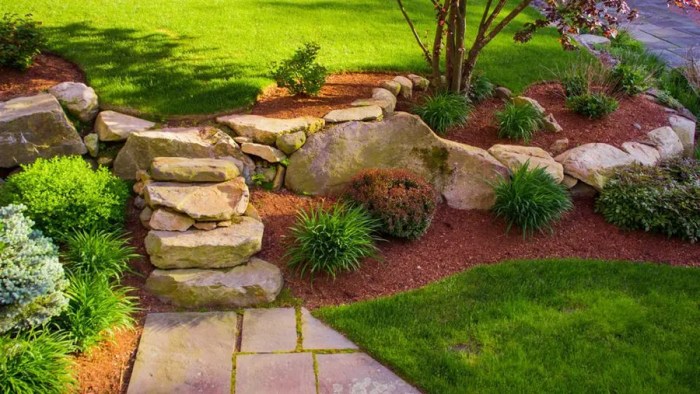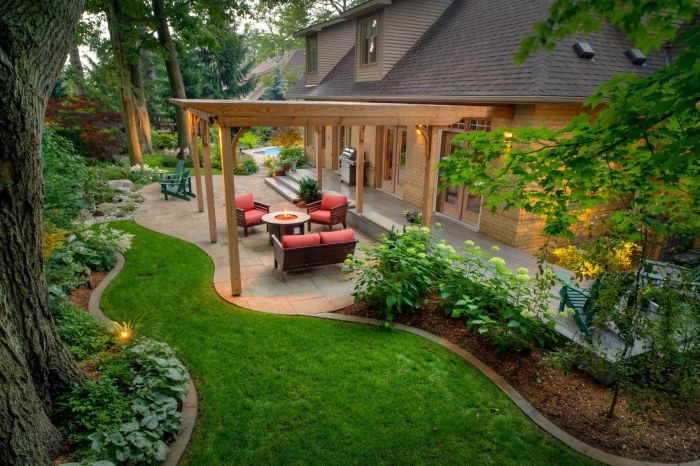Crafting Affordable Backyard Landscaping Solutions

Exploring the realm of affordable backyard landscaping solutions, this introduction sets the stage for a captivating journey into creative and budget-friendly options to enhance outdoor spaces.
Providing insights on cost-effective materials, innovative design ideas, and the advantages of choosing affordable landscaping solutions for your backyard.
Affordable Backyard Landscaping Solutions

Creating a beautiful and functional backyard space doesn't have to break the bank. Affordable landscaping solutions offer a cost-effective way to transform your outdoor area into a relaxing oasis.
Cost-Effective Materials and Plants
When choosing materials and plants for your backyard landscaping, consider options that are budget-friendly without compromising on aesthetics. Some examples include:
- Using gravel or mulch instead of expensive paving stones for pathways
- Opting for native plants that require less water and maintenance
- Repurposing old furniture or DIY projects for outdoor seating areas
Benefits of Affordable Options
There are several benefits to choosing affordable landscaping solutions for your backyard:
- Cost savings: By using budget-friendly materials and plants, you can achieve a beautiful backyard without overspending.
- Easy maintenance: Affordable landscaping options often require less maintenance, saving you time and effort in the long run.
- Creative freedom: Working within a budget can inspire creativity and unique design ideas for your backyard space.
Budget-Friendly Landscaping Ideas
When it comes to designing a backyard on a budget, there are several creative ways to achieve a beautiful outdoor space without breaking the bank. By incorporating DIY projects and cost-effective materials, you can transform your backyard into a welcoming oasis without spending a fortune.
Let's explore some budget-friendly landscaping ideas that can help you save money while enhancing the aesthetic appeal of your outdoor area.
Using Recycled Materials
One budget-friendly landscaping idea is to repurpose and use recycled materials in your backyard design. Items such as old tires, pallets, and broken concrete can be transformed into unique planters, pathways, and seating areas. Not only does this approach help reduce waste, but it also adds a creative touch to your outdoor space without costing a lot.
Low-Maintenance Plants
Choosing low-maintenance plants can also help you save money on landscaping costs. Opt for native plants that are well-suited to your climate and require minimal watering and upkeep. These plants are not only budget-friendly but also sustainable, as they promote biodiversity and attract beneficial insects to your garden.
Mulching and Composting
Another cost-effective landscaping idea is to utilize mulch and compost in your backyard. Mulch helps retain moisture in the soil, reduces weed growth, and adds nutrients to your plants. Composting kitchen scraps and yard waste can also provide free fertilizer for your garden, eliminating the need to purchase expensive chemical fertilizers.
DIY Pathways and Pavers
Instead of investing in expensive paving materials, consider creating DIY pathways and pavers using affordable options such as gravel, stepping stones, or recycled bricks. These DIY projects not only add charm to your backyard but also allow you to customize the design according to your preferences without overspending.
Low-Maintenance Landscaping Techniques
Incorporating low-maintenance landscaping techniques in your backyard can save you time and effort in the long run while still enhancing the beauty of your outdoor space. By selecting the right plants, strategically planning your landscape, and implementing smart design choices, you can create a low-maintenance backyard that looks great year-round.
Low-Maintenance Plants and Shrubs
When choosing plants for your backyard landscape, opt for varieties that require minimal care and attention. Consider native plants that are well-adapted to your region's climate and soil conditions. Some examples of low-maintenance plants and shrubs include:
- Native grasses such as switchgrass or bluestem
- Drought-tolerant succulents like sedum or yucca
- Evergreen shrubs such as boxwood or holly
- Perennials that bloom year after year with little maintenance
Importance of Strategic Planning
Strategic planning is key to creating a low-maintenance backyard landscape. By carefully considering factors such as sunlight exposure, soil quality, and water availability, you can design a landscape that thrives with minimal intervention. Some tips for strategic planning include:
- Grouping plants with similar water and sunlight needs together
- Using mulch to retain moisture and reduce weed growth
- Installing drip irrigation systems for efficient watering
- Choosing hardy plants that are less susceptible to pests and diseases
Designing a Low-Maintenance Backyard
You can design a low-maintenance backyard that is still aesthetically pleasing by incorporating elements such as:
- Hardscaping features like gravel paths or stone patios
- Creating defined planting beds with borders or edging
- Adding decorative rocks or boulders for visual interest
- Planting ground cover plants to reduce the need for mowing
Eco-Friendly Backyard Landscaping

When it comes to landscaping, opting for eco-friendly practices not only benefits the environment but also your wallet in the long run. Eco-friendly landscaping focuses on reducing water consumption, minimizing chemical usage, and creating a sustainable outdoor space that thrives naturally.
Sustainable Landscaping Practices
- Plant Native Species: Choose plants that are indigenous to your region as they are better adapted to the local climate and require less water and maintenance.
- Water Conservation: Install a rainwater harvesting system to collect and reuse rainwater for irrigation purposes, reducing the need for additional water sources.
- Xeriscaping: Design your backyard with drought-tolerant plants, rocks, and mulch to create a low-maintenance landscape that conserves water.
- Composting: Create a composting bin to recycle organic waste into nutrient-rich soil for your garden, reducing the need for chemical fertilizers.
Long-Term Cost Savings
While there may be an initial investment in implementing eco-friendly landscaping practices, the long-term cost savings are significant. By reducing water consumption, minimizing the use of chemicals, and lowering maintenance requirements, you can save money on your water bills, landscaping services, and plant replacements over time.
Additionally, eco-friendly landscapes are more resilient to environmental changes, ensuring the longevity and health of your outdoor space.
Final Conclusion
In conclusion, affordable backyard landscaping solutions offer a blend of practicality and aesthetics, proving that you don't need to break the bank to create a stunning outdoor retreat.
FAQ Compilation
What are some cost-effective materials for backyard landscaping?
Some examples include pea gravel, mulch, recycled materials, and native plants that require less maintenance.
How can I reduce landscaping costs through DIY projects?
DIY projects like building raised garden beds, creating recycled planters, and installing a drip irrigation system can help save money on landscaping.
What are some low-maintenance plants suitable for a backyard landscape?
Plants like succulents, ornamental grasses, and lavender are excellent choices for a low-maintenance backyard.
What are the benefits of eco-friendly backyard landscaping?
Eco-friendly landscaping helps conserve water, reduce chemical usage, and create a healthier environment for plants, animals, and humans.
How can eco-friendly landscaping practices save costs in the long run?
By using sustainable practices like rainwater harvesting, composting, and native plant selection, you can reduce water bills and maintenance expenses over time.

